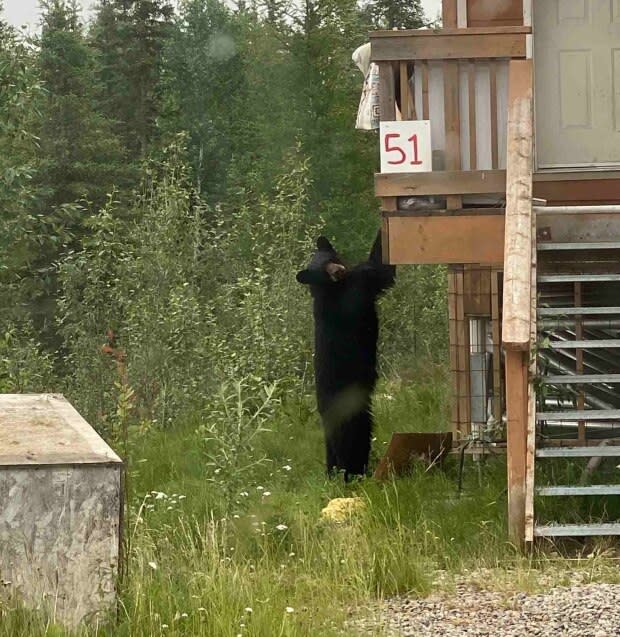Cinnamon-coloured bear with distinctive neck spotted in Fort Good Hope
A bear sighting in Fort Good Hope, N.W.T., over the weekend caused a bit of a stir.
It's not that bears are unusual in that neck of the woods — even cinnamon-coloured bears like this one have been seen before — what has people talking is the length of the bear's neck.
Jim Tobac took a photo of the animal Saturday evening at the local landfill, about two or three kilometres away from Fort Good Hope.
He said he's never seen a bear like this one before.
"Not with a neck like that," Tobac said.
"I've never seen a bear with a long neck like that before. Its hair was shaggy like a grizzly bear. It didn't seem aggressive or anything, it was just sitting there in the dump."
Tobac posted his photo to Facebook where others commented that the long neck had them thinking this might be some kind of grizzly or black bear and polar bear hybrid.
Its hair was shaggy like a grizzly bear. - Jim Tobac, Fort Good Hope resident
But Joslyn Oosenbrug, a spokesperson for the N.W.T. Department of Environment and Natural Resources (ENR), said in an email that the report of a possible grizzly bear in the area was mistaken. There were only black bears.
Jeff Walker, ENR superintendent for the Sahtú region, said a cinnamon coloured black bear could be mistaken for a grizzly from a distance.
"Black bears range anywhere from a very dark brown to a blond — with brown in between — and different shadings," Walker said. "A cinnamon bear is actually a black bear, it just has a different colour phase. Just like people, bears have different coloured hair."
The differences to look out for between black bears and grizzlies, he said, are the pronounced shoulder hump, large paws and claws, and the concave or dished face of the latter. Black bears, of whatever colour phase, will have a shorter nose, no shoulder hump and small paws and claws.
As for the long neck, Walker said that could be explained by it being a juvenile bear — Tobac said the bear looked young — having not fully grown into its body yet.
Walker said he's not aware of any grizzly/polar bear hybrids in the Sahtú, and that a grizzly black bear hybrid was very unlikely, although polar bears have been seen in the Sahtú before.
"A few years ago they came to Délı̨nę from Kugluktuk, following a group of harvesters," Walker said. "That's the only known case of polar bears in the Sahtú that I know of."

Three bears, including the cinnamon bear, were reported to ENR over the weekend.
The department is doing what it can to get the bears to leave the area. It's not only in the interest of people's safety, it's also in the interest of the bears' continued existence.
Once they become habituated to wandering into the community looking for food they become dangerous. If the bears cannot be deterred from entering the community, they will be killed.
"We try every effort to train the bears to stay out of town as much as possible," Walker said.
"Unfortunately, because of our isolation here and our lack of roads and our inability to move them any distance that's meaningful … from the community ... we find ourselves having to euthanize these bears."
The department reminds residents to be bear aware, and to keep indoors anything that might attract bears: food, pet food, fish or game meat and any remains, as well as any clothing, blankets or other fabrics that may smell like food.
"We do live in their backyard," Walker said. "Just be bear aware when you're out there."
Wildlife officers have set up a live bear trap near the community. They ask people to stay away from the trap.
Fort Good Hope residents who spot a bear in the community should call the 24-hour wildlife emergency phone line, (867) 587-2422, or the Fort Good Hope Wildlife Officer at (867) 496-0516.

